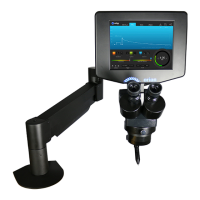i Series User Manual
8
0.6 - 0.7in (1.5 – 2cm) of the electrode protruding from the stylus shaft. is will allow the
electrode enough room to stick out from the stylus once the stylus hull is placed back on
the stylus.)
5. ere should be between 0.6 - 0.7in (1.5 – 2cm) of the electrode protruding from the stylus
shaft. is will allow the electrode enough room to stick out from the stylus once the stylus
hull is placed back on the stylus.)
6. Lock the electrode into place by hand tightening the collet cap in a clockwise direction.
7. Replace the stylus hull by pushing it snuggly until you feel it snap back into place (the electrode should stick out
between 1/8 – 1/4in (3.75 – 6.75mm) after the stylus hull is snapped back into place).
WORKPIECE TO ELECTRODE PRESSURE
Touch the work-piece to the electrode with very light pressure. Too much pressure will cause the work-piece to stick to the
electrode and in turn cause the electrode to be contaminated (work-piece material on the electrode). is will shorten the
amount of time you can weld before re-sharpening or replacing the electrode. *As a general rule of thumb we recommend a
freshly sharpened electrode anytime a new work-piece is being welded.
WHEN TO SHARPEN THE ELECTRODE
It is recommended that the user pay close attention to the electrode condition. An electrode that appears to be dark
colored or covered with material from previous welds can lead to inconsistent welding and poor igniting of the weld. When
this occurs, simply sharpen the electrode with the included diamond disk. e diamond disk can be attached to a flex shaft
or Dremel tool. Follow these steps for sharpening the electrode. Visit the videos tab at orionwelders.com for additional
information and tutorials.
1. Completely remove the electrode from the stylus.
2. Pinch the electrode between the thumb and middle finger with the point facing inward.
3. Power on the Dremel or flex shaft then hold it with the opposite hand.
*If the Dremel is in the left hand, then sharpen the electrode on the side
of the diamond disk furthest from the body. If the Dremel is in the right
hand, then sharpen the electrode on the side of the diamond disk closest
to the body. e reason for this is to keep the striations on the electrode
moving towards the electrode tip, not away. is will effect the quality of
the weld if not done as explained above.
4. Set the electrode on the diamond disk at a 15-degree angle and begin
to spin the electrode with the thumb and middle finger. *A helpful way
to get a sharp electrode is to push down on the electrode with your
index finger while twisting the electrode with the thumb and middle finger. See the video on our website for additional
instruction on this method.
5. Once the electrode is sharp and clean, turn the Dremel off and insert the electrode back into the stylus as explained
above.
WHEN TO FLATTEN/BLUNT THE ELECTRODE
When working with silver, copper, and other highly conductive metals in energy levels above 20ws, it is recommended
to blunt the electrode instead of sharpening it. Visit the videos tab at orionwelders.com for additional information and
tutorials.
1. Completely remove the electrode from the stylus.
2. Pinch the electrode between the thumb and middle finger with the point facing inward.
3. Turn the Dremel or flex shaft on then hold it with the opposite hand. *If the Dremel is in the left hand, then sharpen
the electrode on the side of the diamond disk furthest from the body. If the Dremel is in the right hand, then sharpen
the electrode on the side of the diamond disk closest to the body. e reason for this is to keep the striations on the
electrode moving towards the electrode point, not away. is will effect the quality of the weld if not done as explained

